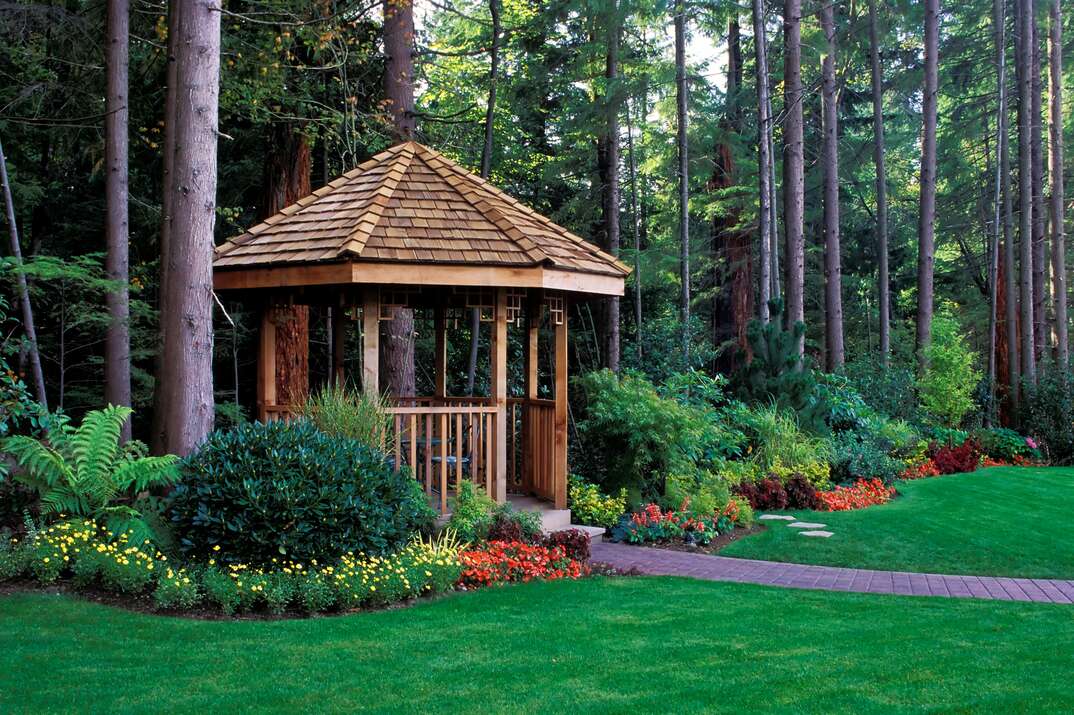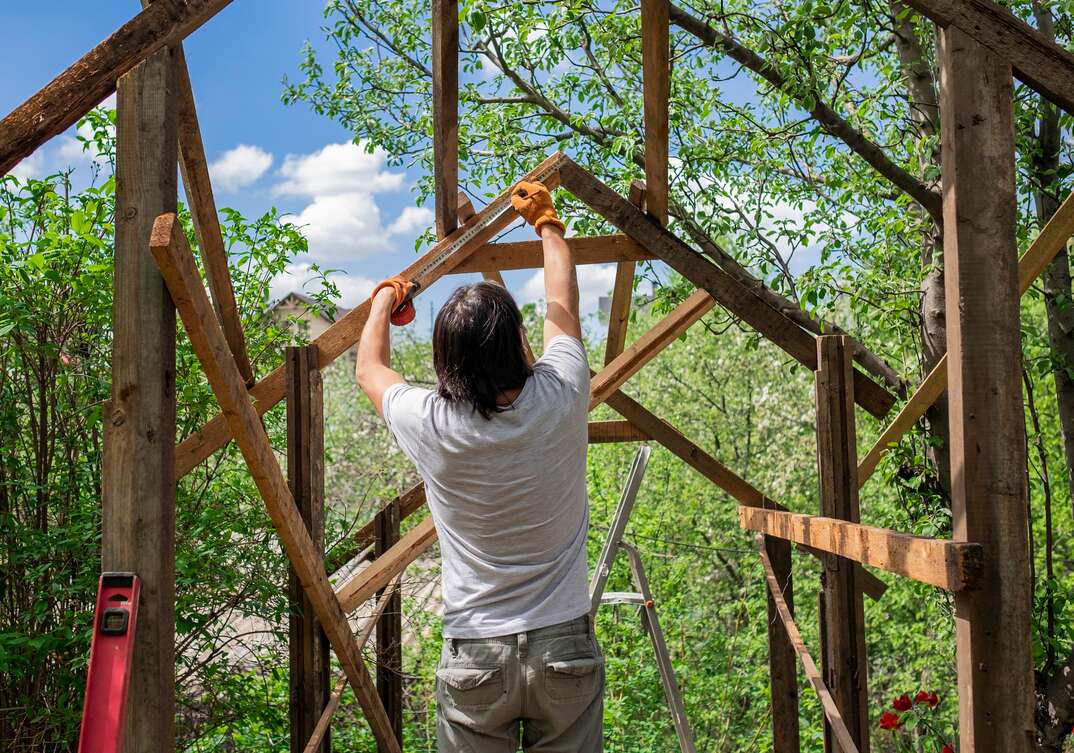How to Build a Gazebo

Building a Gazebo at a Glance
- Step 1: Call 811 and obtain permits
- Step 2: Create base
- Step 3: Dig post holes and place posts
- Step 4: Secure support and top beams
- Step 5: Build and raise walls
- Step 6: Add roof
- Step 7: Add water seal and finishing touches
Want to enjoy your wide-open yard without being scorched by the sun on hot summer days? In addition to providing a place of shade and an area where guests can enjoy themselves, a gazebo adds elegance and beauty to your landscape.
This May Also Interest You: How to Build a Deck
If you know how to build a deck, building a gazebo shouldn’t be that difficult of a task. All you need are the right supplies, knowledge of your local building ordinances governing backyard structures and this gazebo-building guide.
What Is a Gazebo?
A gazebo is an outdoor structure that normally has six or eight sides, an entrance and a roof. While less popular, there are rectangular gazebos that have only four sides. The sides of the gazebo are partially open with ornamental fencing, and the structure may be placed on a wood floor or a concrete slab. The main purposes of a gazebo are to add a space to your yard for people to congregate, to provide shade and to increase the visual appeal of your backyard. They can also provide you with a place to sit and dry off after a swim in your pool.
Gazebos come in many sizes. You can choose from 10-foot by 10-foot or 16-foot by 16-foot hexagonal or octagonal gazebos, or 10-foot by 12-foot rectangular gazebos. If you are creating your own design, you could potentially go as big and bold as you would like.
Can I Build a Gazebo in My Backyard?
Unless there is something specific in your homeowners association bylaws that states you can't, you shouldn't have any problem obtaining permission to build a gazebo on your property. Most localities don’t even require a building permit to do so. But just in case you live in a city that does require one, it's best to check that out before proceeding. You'll also want to make sure you take all of the necessary actions to ensure the safety of your project. This includes calling 811 and having your utility companies come out to mark where your electric, water and gas lines are running beneath your lawn.
There are plenty of DIY gazebo kits available that provide all the materials you need, as well as instructions that make it easy to plan your build and put it together. You may not have any clue where to begin with this project, but if you know how to follow instructions and have some experience building things, you can certainly tackle this task. It’s even easier if you know how to or have built a deck in the past.
Choosing the Materials for Your Gazebo
There are many materials that work for building a gazebo, and each has its benefits and disadvantages. Popular materials include aluminum, fiberglass, teak, cedar, redwood and composite. The type of material you choose influences the cost of your project.
Metal and fiberglass are much more durable but less visually appealing, so most people choose some form of wood or composite. If you want to reduce your carbon footprint, a wood composite will give the appearance of wood without actually using material from trees. Composite is made from recycled plastics.
If you're more concerned about your budget, it's recommended to go with wood products because they are less expensive than composite — though surging lumber costs have made the two materials more comparable in price. Aluminum is the cheapest option, but it's also the most limiting in regard to visual appeal. Supply and demand in your region will also determine the price you pay for materials.
More Related Articles:
- How to Stain and Seal your Deck
- How Much Does It Cost to Build a Deck?
- How Much Does It Cost to Build a Shed?
- How to Build a Shed: An 8-Step Overview
- How to Build a Fire Pit
How Do I Make a Homemade Gazebo?
When considering how to build a gazebo, it is important that you review all your options. Select the materials you wish to use for each part of the structure — from the posts to the roof. Choose colors that match or complement your home, and decide whether you’ll be adding any finishing touches to truly make it your own.
Once you have a blueprint in mind, purchase the materials that you need. As mentioned previously, you can buy gazebo kits that come with most of the items that you need. If you would prefer to use your own materials, there are online DIY gazebo designers that let you create a design using your own dimensions. Based on that, they’ll tell you all the things you need to purchase to achieve the look. Many of these programs let you choose custom materials as long as they fit in the dimensions you have selected.
Once you have ordered and received your materials, follow these steps:
Step 1: Prep Work
Confirm whether you need a building permit. If you do, make sure that you have your permit in hand before you break ground on your project.
Next, contact your utility companies to come out and identify the locations of their lines under your property. You can call 811 (or your local before-you-dig number) to connect with the appropriate technicians to do this for you. The last thing you want to do is electrocute yourself or rupture a gas line in your yard.
Step 2: Create a Base
Create a level base for building a gazebo. It doesn't matter if you're placing it on a concrete slab or a wood base; the ground the structure will stand on needs to be solid and level to avoid the collapse or premature deterioration of your building.
If using concrete, pour the base and let it set. Some people use metal rebar to add structural integrity, but this is completely up to you. If using a wooden base, screw all the outer boards of the base together first and check that they are level before attaching the flooring to the base.
Finalize your plans and make sure that you understand what you are setting out to do. The worst time to change plans is mid-project. Once you begin, you should be committed to your plans and follow them through.
 -------------------------------------------
-------------------------------------------
Step 3: Dig Post Holes and Place Posts
Use a post hole digger to dig the holes you need for your posts. Before you do this, make sure the posts are where you want them because you’ll have a big mess to clean up if you dig the holes in the wrong places.
Review your plans, then cut each post to the lengths specified. Once you’ve cut them to the right size, place them into their holes and use a quick-set concrete to lock them into place. The concrete will add integrity to your structure and help secure the posts.
 -------------------------------------------
-------------------------------------------
Step 4: Secure Beams to the Posts
Secure the supporting beams to the posts and make sure to use a level to ensure they are perfectly perpendicular. You want to use bolts for this step to make sure that they hold. Place them through the post and into the center of each beam. Secure the top beams to the top of the posts in the same way you secured the supporting beams.
Step 5: Add Walls
Next, create your walls. Your plans should include how to put together each of the walls that you need, including the entranceway. Make sure to build your walls before moving to the next step so that you have them ready.
Raise the walls and attach two of them first. The best way to do this is with screws. Once you have the first two walls attached, you should be able to move one wall at a time until you are finished with all of them.
Step 6: Construct a Roof
Add a roof to your gazebo. Just as you did before with the other beams, you will need to first measure and cut your roof beams to make sure they are the correct size. Attach all of them into their places, then place the fascia boards and shingles as you would handle any roofing project.
Step 7: Finishing Touches
Protect your new gazebo by adding a water seal to your wood to prevent decay and weathering.
Once you have finished building a gazebo, consider how to make it stand out as your own. You could use wood stain or paint, then add foliage or vines for an elegant appearance. Many people add hanging plants inside and flower boxes outside the structure. You might also consider installing a swing for some added flair. These final touches contribute to the value your gazebo adds to your home. That said, don’t go overboard; less is more. Everything you add should serve a clear decorative purpose.
Now, you have your own outdoor refuge from the savage rays of the sun and a place to entertain guests or just relax.
Will a Gazebo Add Value to My Home?
Most of the time, any addition you make to your home will increase its value. Adding a unique gazebo creates something your home has that other homes in your neighborhood might lack. This exclusive feature will stand out to potential buyers and fetch higher value offers. It may also make it easier to sell your home in general.
People like to spend time outdoors while maintaining privacy, so a gazebo is a nice bonus if you are looking to sell your home. Just how much your gazebo will increase the value of your home depends on factors like demand, the materials used, its appearance, upkeep and how many other homes in your area have one.


